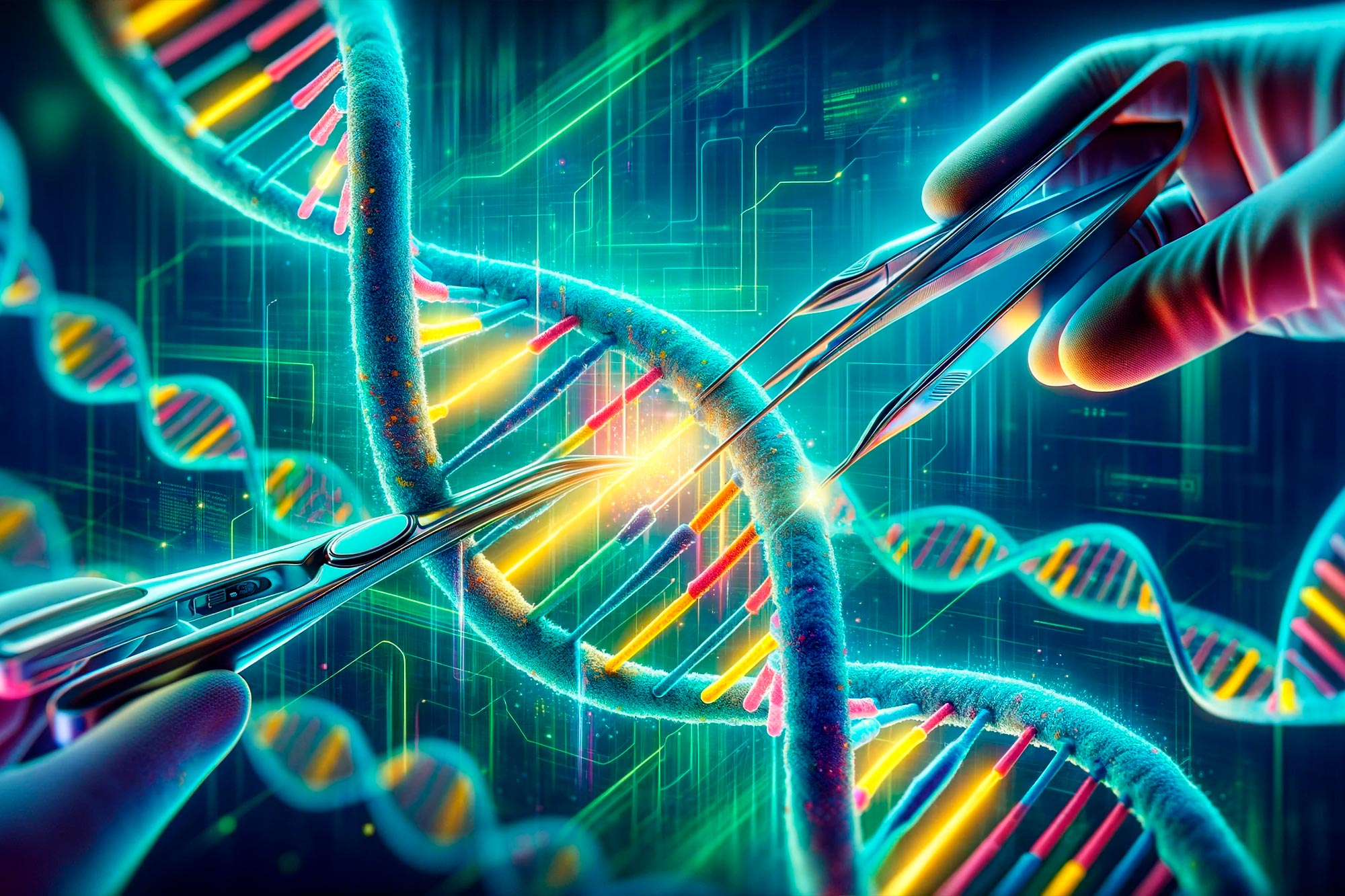Gene editing has emerged as a revolutionary technique in modern science, offering new hope for patients with genetic diseases. Utilizing advanced methods like base editing and prime editing, researchers can precisely alter the DNA sequence to correct mutations responsible for conditions such as cancer. This groundbreaking CRISPR technology not only allows for targeted interventions but also paves the way for innovative cancer treatments that were once deemed impossible. The potential to rewrite genetic destiny opens doors to personalized medicine, transforming the way we approach hereditary diseases. As we continue to explore the vast possibilities of gene editing, the medical community stands on the brink of a new era in healthcare.
DNA manipulation, often referred to as gene modification, represents a significant leap in our understanding and treatment of various genetic ailments. This cutting-edge approach employs techniques akin to programming, wherein scientists can reprogram genes much like editing a document. By utilizing tools like CRISPR and its derivatives, such as base and prime editing, researchers aim to rectify harmful genetic mutations that lead to debilitating conditions, including some forms of cancer. The ability to modify genetic information not only enhances our knowledge of molecular biology but also holds immense promise for developing targeted therapies. As ongoing research expands our capabilities in this field, the prospects for improved health outcomes grow ever more promising.
Understanding Gene Editing: The Future of Medicine
Gene editing represents a revolutionary frontier in modern medicine, allowing scientists to manipulate the genetic framework of living organisms with unprecedented precision. This cutting-edge technology has the potential to redefine how we approach the treatment of genetic diseases, providing insights that could lead to miraculous advances in patient care. With the advent of gene editing techniques such as CRISPR, base editing, and prime editing, researchers are now equipped to not only disrupt harmful genes but also to correct mutations at the nucleotide level.
The significance of gene editing becomes apparent when we consider the vast landscape of genetic diseases affecting millions globally. Conditions like sickle cell anemia, muscular dystrophy, and various cancers have long been challenging for medical professionals, often leaving patients with limited options. However, through the strategic application of gene editing technologies, we are beginning to witness remarkable successes in clinical trials. Stakeholders in the health sector are particularly encouraged by these developments, which promise to shift the paradigm of what is possible in genetic therapy.
The Breakthrough of Base Editing in Cancer Treatment
Base editing has emerged as a groundbreaking approach to gene therapy, particularly in the context of cancer treatment. Unlike traditional CRISPR techniques, which involve cutting the DNA helix, base editing allows scientists to make direct modifications to the DNA bases themselves. By targeting the four essential nucleotide bases—adenine, cytosine, guanine, and thymine—researchers can correct specific mutations that lead to cancer, providing a more precise and less invasive option for patients.
The application of base editing in clinical settings has been heralded by success stories such as that of Alyssa Tapley, who benefited from a pioneering trial. The implications of such advancements are vast; base editing not only has the potential to offer new hope to those diagnosed with T-cell leukemia but also paves the way for the treatment of a multitude of genetic cancers. As ongoing research continues to unveil the possibilities, there’s a growing optimism in the medical community about the capacity of this innovative technology to save lives and improve outcomes for cancer patients.
Prime Editing: A Next-Level Approach to Gene Correction
Prime editing is another transformative approach that builds upon the successes of CRISPR and base editing, offering even greater accuracy in gene correction. Unlike other methods which may inadvertently introduce errors or lead to unintended consequences, prime editing is likened to a word processor for DNA, enabling researchers to locate and replace faulty genetic sequences with precision. This level of control not only increases efficacy in correcting genetic defects but also minimizes potential side effects.
The development of prime editing signals a new era in the potential treatment of genetic disorders, affording opportunities to address a broader range of mutations. With its ability to correct a variety of single-letter and multi-letter genetic mistakes, prime editing emerges as a powerful tool for tackling complex genetic diseases, including those that were previously considered intractable. The excitement surrounding this technology is palpable within the scientific community, as researchers are keen to explore its applications in clinical trials, potentially transforming the landscape of genetic medicine.
The Role of CRISPR Technology in Modern Genetics
CRISPR technology has revolutionized genetics over the past decade, offering a method to edit genes with far-reaching implications. Originally discovered as part of the bacterial immune system, CRISPR has been repurposed for remarkable advancements in genetic engineering. By allowing for precise cuts and modifications in the DNA sequence, it serves as a foundational technology that has inspired further innovations like base and prime editing.
As scientists continue to harness the capabilities of CRISPR, they are unraveling new mysteries of genetics while addressing pressing medical challenges. Its application extends beyond basic research to the treatment of diseases such as genetic disorders and even certain types of cancers. The increasing number of clinical trials that utilize CRISPR technology exemplifies its significance in developing new therapies, solidifying its status as a cornerstone in the fields of genetics and molecular biology.
Revolutionary Impact on Genetic Diseases
The advent of gene editing technologies has brought about a paradigm shift in the understanding and treatment of genetic diseases. Researchers have begun to unravel the complex interplay of genetic mutations leading to conditions such as cystic fibrosis, Huntington’s disease, and various forms of cancer. By employing techniques like CRISPR and base editing, scientists are now able to directly target and correct these mutations at their source, leading to more effective treatments and, in some cases, potential cures.
The implications of such advances are monumental, particularly for individuals who have historically been sidelined by their genetic conditions. With ongoing research efforts, the possibility of eliminating genetic diseases from future generations is inching closer to reality. Enhanced gene editing techniques are paving the way for ethical debates on the potential for designer genes, raising questions about the limits and responsibilities that accompany such powerful capabilities in the realms of science and medicine.
Ethical Considerations in Gene Editing
As we venture deeper into the world of gene editing, ethical considerations surrounding these transformative technologies become increasingly paramount. The ability to edit human genomes raises questions about consent, unintended consequences, and the potential for creating inequalities in healthcare. Discussions about who should have access to these cutting-edge therapies, as well as the implications of gene editing on future generations, are critical to shaping a responsible approach to research and implementation.
Moreover, the potential for gene editing to enhance or alter human traits has led to robust dialogues in both the scientific community and the public sphere. The fear of ‘designer babies’, where parents could select desired traits for their offspring, poses both ethical dilemmas and societal concerns. As researchers like David Liu work to provide safer and more effective gene editing solutions, the importance of establishing a solid ethical framework cannot be overstated, ensuring that progress in genetic medicine benefits humanity as a whole.
Supporting the Next Generation of Scientists
The future of gene editing and related fields relies heavily on fostering the next generation of scientists. As concerns about funding and support for scientific research grow, it becomes essential to cultivate an environment that encourages young researchers to innovate and explore new frontiers in biotechnology. Mentorship programs, accessible research facilities, and adequate funding from government and private sectors are crucial to enabling these emerging talents to realize their potential.
In addition to practical support, creating an inclusive culture where diverse ideas can flourish is vital. Young scientists bring fresh perspectives and innovative approaches that can challenge traditional paradigms and lead to groundbreaking discoveries. By investing in education and collaboration opportunities in genetics and molecular biology, society can ensure that the pioneers of tomorrow will continue to march forward in solving the pressing challenges of today, particularly in healthcare.
Clinical Trials: New Frontiers in Gene Therapy
The conduct of clinical trials using gene editing technologies such as base and prime editing has opened up new frontiers in gene therapy. With multiple trials already under way for various genetic disorders, researchers are gathering critical data that could confirm the effectiveness and safety of these cutting-edge treatments. For patients like Alyssa Tapley, who have participated in these trials, the outcomes offer hope that innovative gene therapies could lead to significant improvements in quality of life and long-term health.
The success or failure of these clinical trials not only affects individual participants but also shapes the future landscape of genetic research. The findings will influence regulatory policies, funding decisions, and the broader acceptance of gene therapy as a legitimate treatment pathway. As patient data continues to be collected and analyzed, both scientists and stakeholders must remain vigilant about safety, ethics, and accessibility, ensuring that the benefits of advancements in gene editing can be realized by all who need them.
Innovations from Basic Science to Applied Genetics
The journey from basic science to practical applications in genetics is an exhilarating one, exemplified by the work of researchers like David Liu. Initially focused on understanding genetic phenomena, Liu illustrates how curiosity-driven research can yield transformative applications in human health. The exploration of CRISPR technology, for instance, stemmed from simple observational studies in bacteria, eventually leading to groundbreaking tools capable of revolutionizing genetic medicine.
This transition from theoretical frameworks to tangible medical solutions showcases the intertwined relationship between basic and applied sciences. Research that begins with fundamental questions often manifests in life-changing technologies that address critical health issues across the globe. The ongoing exploration of gene editing methodologies serves as a powerful reminder of the potential that lies in scientific inquiry, pushing boundaries and innovating solutions for humanity’s most pressing genetic challenges.
Frequently Asked Questions
What is gene editing and how does it work?
Gene editing is a scientific technique that allows for the alteration of an organism’s DNA. It uses tools like CRISPR technology, base editing, and prime editing to make precise changes to the nucleotide sequences in the genome. This technology can correct mutations that cause genetic diseases by either cutting DNA to disable genes or making specific base changes without cutting the entire helix.
What are some applications of base editing in genetic diseases?
Base editing is a form of gene editing that allows for the precise alteration of individual base pairs within DNA. This technique has shown promise in treating genetic diseases by correcting common mutations. For instance, base editing can convert a cytosine (C) to a thymine (T) to fix mutations associated with conditions like sickle cell disease and certain types of leukemia.
How does prime editing offer advantages over traditional CRISPR technologies?
Prime editing is often described as a more versatile and precise form of gene editing than traditional CRISPR. Unlike CRISPR, which cuts the DNA strands, prime editing can search for specific genetic sequences and make targeted changes without causing double-strand breaks. This reduces the risk of unintended mutations and opens up new possibilities for correcting a broader range of genetic diseases.
Can gene editing technology like CRISPR help in cancer treatment?
Yes, gene editing technologies such as CRISPR and base editing are being explored for use in cancer treatment. By targeting and altering specific genes associated with cancer growth and survival, researchers hope to develop therapies that can effectively combat various types of cancer while minimizing damage to healthy cells.
Are there any clinical trials currently using gene editing technologies?
Yes, as of today, there are at least 18 clinical trials underway that utilize base editing and prime editing to treat a variety of genetic diseases. These trials represent a significant step forward in precision medicine, with patients receiving innovative therapies based on cutting-edge gene editing techniques.
What are the potential risks associated with gene editing technologies?
While gene editing technologies like CRISPR, base editing, and prime editing offer groundbreaking potential, they also carry risks. These include the possibility of off-target effects, where unintended changes occur in the genome. Ongoing research aims to enhance the safety and accuracy of these techniques to minimize risks for patients undergoing gene editing therapies.
How has gene editing technology evolved since the discovery of CRISPR?
Since the discovery of CRISPR-Cas9, gene editing has evolved significantly with the development of new methods such as base editing and prime editing. These advancements allow for more precise modifications of the genome, expanding the potential applications of gene editing in addressing genetic diseases and enhancing therapeutic strategies.
What role does basic science play in the development of gene editing technologies?
Basic science is crucial in understanding the fundamental biological mechanisms that underlie gene editing technologies. Research into processes like the natural defense mechanisms of bacteria led to the development of CRISPR and its subsequent derivatives. This foundational knowledge drives innovation and the application of gene editing in medicine.
What is the significance of gene editing for future medical therapies?
Gene editing holds tremendous potential for transforming medical therapies by enabling precise corrections of genetic mutations responsible for diseases. This could lead to new treatments for previously untreatable genetic disorders, and potentially provide cures for conditions such as cancer and inherited diseases, thereby improving patient outcomes.
| Key Aspect | Details |
|---|---|
| Gene Editing Technology | Base editing and prime editing are two innovative gene-editing technologies developed to address genetic diseases. |
| Case Study | Alyssa Tapley, a patient with T-cell leukemia, was saved by a clinical trial utilizing base editing, demonstrating the potential of the technology. |
| Key Scientist | David Liu, notable for his contributions to gene editing, emphasizes the responsibility to ensure safety and efficacy in treatment applications. |
| CRISPR Background | CRISPR, initially discovered as an immune response in bacteria, laid the groundwork for modern gene editing techniques. |
| Current Research | At least 18 clinical trials are currently investigating the uses of base editing and prime editing for various genetic conditions. |
| Future Concerns | Concerns regarding the relationship between higher education and federal support may hinder the advancement of young scientists in the field. |
Summary
Gene editing is revolutionizing the field of genetics by providing novel ways to address and potentially cure genetic diseases. Through pioneering techniques such as base editing and prime editing, scientists like David Liu are transforming the landscape of medical treatments, as evidenced by successful trials that have already impacted patients’ lives. As ongoing research continues to unlock the potential of gene editing, it becomes increasingly significant in the quest for effective genetic disease solutions.




